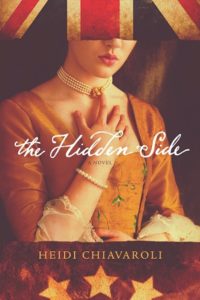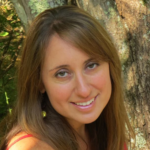In the split-time novel The Hidden Side, two women—connected across centuries by a journal—struggle with living behind a façade.
Christian author Heidi Chiavaroli loves exploring places that whisper of historical secrets. Her novel The Hidden Side (Tyndale House) is the story of two families—one in 1776, the other in 2016—dealing with secrets and shame. In this interview, the author shares the surprising details that came out of her research, the role that faith plays in The Hidden Side, and the power of hope during trials…
What inspired you to write The Hidden Side?
 My ideas usually begin with research. I was searching for a true-to-life historical figure from the American Revolution who could inspire a new story when I stumbled upon Agent 355, a woman who played an important part in General George Washington’s most successful spy ring, a woman whose identity we still don’t know for certain. That was enough to get my imagination going!
My ideas usually begin with research. I was searching for a true-to-life historical figure from the American Revolution who could inspire a new story when I stumbled upon Agent 355, a woman who played an important part in General George Washington’s most successful spy ring, a woman whose identity we still don’t know for certain. That was enough to get my imagination going!
Before long, I had a solid historical story down—a story about a woman seeking to redeem the wrong done to her fiancé, infamous spy Nathan Hale. A story about a woman hiding behind a facade that could not only ruin every relationship she has but could put her life in peril as well. A story about a woman who finds herself caring for a man she must deceive.
The contemporary story didn’t come so easily. I was brainstorming with my friend and fellow author Melissa Jagears when we remembered a recent news story about a man who had committed a terrible crime and an interview with a relative who raised him, who was just as shocked as the rest of the country over what her kin had done.
Before long—and with additional help from my extraordinary editor, agent, and critique partner—we had the story of Natalie, a mother and radio host of a popular Christian morning show, whose son had committed an unspeakable crime. This woman would go through grief, but she would also struggle with moving on, with the impulse to hide behind her radio personality, and with finding her identity not in her son’s deeds but in Christ.
Through her attempt to find healing, she turns to the journal her son gave her on the eve of his crime, a journal that tells the story of another woman, centuries earlier, who also felt the need to hide behind a false persona.
How do you expect this story to resonate with your audience?
Although most of us haven’t gone through something as horrific as Natalie, Maelynn, and Mercy, we have probably all struggled with the different masks we find ourselves wearing. We struggle to discover our “true” selves. How often does who we truly are fail to translate into who we walk around being?
Natalie hides from the shame caused by her son’s actions behind a radio name. Filled with grief, she convinces herself she will hurt fewer people if she lives behind this facade.
Her daughter, Maelynn, is a sixteen-year-old who struggles with fitting in with her peers. When her twin brother commits his unspeakable crime, she begins to realize how living untruth to please others has hurt not only her brother, but her entire family and community.
And Mercy, like Natalie, feels she is fighting for a good cause. But when her noble intentions collide with those she cares for, she finds herself wondering if living untruth can ever produce something good.
Can you tell us about the historical research that went into writing this novel? Did you learn anything new that surprised you?
 Research is always one of my favorite parts of writing a novel. After I read everything I could on the Culper Spy Ring, we visited the village of Setauket on Long Island. This was the hometown of real historical people who were part of the ring—Abraham Woodhull, Major Benjamin Tallmadge, Caleb Brewster, and Anna Smith Strong.
Research is always one of my favorite parts of writing a novel. After I read everything I could on the Culper Spy Ring, we visited the village of Setauket on Long Island. This was the hometown of real historical people who were part of the ring—Abraham Woodhull, Major Benjamin Tallmadge, Caleb Brewster, and Anna Smith Strong.
These were ordinary people who dealt with suppression and, through the prompting of George Washington, used the trust they already held for one another to conduct a covert group that would smuggle information out of British-occupied Manhattan.
As Mercy came alive in my mind, it was wonderful to visit the very places she would have grown up, the places she walked and lived and worshipped and worked. Love that stuff!
I think the most fascinating fact I learned was how adamant the members of the spy ring were about keeping their secret—most of them until death. With the exception of the brazen Caleb Brewster, the members of the Culper Spy Ring were extremely hesitant to talk of the role they played in their country’s freedom, even years after it happened.
In fact, it wasn’t until the twentieth century that Robert Townsend’s role in the ring came to light. That’s how scared they were. That’s how ashamed many of them felt living beneath false motives. And yet they persevered for what they considered to be the greater good.
Click through to find out the role that faith plays in the novel…


